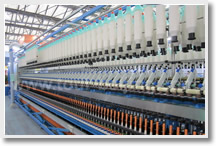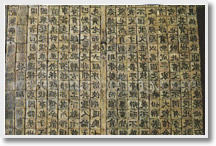Science and Technology of Ancient China
Textile Technique – Chinese Culture
Huang Daopo lived in late years of the Song Dynasty (960-1279) and the early years of the Yuan Dynasty (1206-1368). Huang Daopo lived with the Li women, with whom she had established deep friendship. Meanwhile, Huang had learnt from them a series of techniques of planting as well as cotton spinning and weaving.

Being gray at her temples, Huang Daopo returned to her hometown 30 years later. She taught the Songjiang people the textile technique she had learnt in Hainan Island. At the same time, she also popularized and improved many textile machines so that the efficiency of labor was greatly increased.
She improved greatly on the cotton fluffer and successively invented a tool for cotton-spinning, a pedal spinning wheel with three spindles, which was the most advanced one at that time.
After Huang Daopo’s death, the local people buried her near Wunjing Town, and also produced a ballad to commemorate the ancient clever woman who was ordinary but great.
Zu Chongzhi and Pi – Chinese Culture
There is a crater on the back of the moon, which has been named after Zu Chongzhi, who was a famous mathematician, astronomer and mechanic in the Northern and Southern dynasties (420-589).
The achievement he made in the calculation of the value of pi has been internationally acknowledged. Based on earlier research, he resorted to the “Cutting Circle Method” and concluded that the value of pi falls between 3.1415926 and 3.1415927 after more than 1,000 times of calculation.
Zu Chongzhi also put forward the viewpoint that the approximate value of pi was 355/113, which was called “milv”, which had boosted the calculation of pi to a new phase. Japanese scientists respectfully called the approximate value of pu “Zu Ratio”.
Gunpowder – Chinese Culture
The formula of the gunpowder was initially discovered by Taoist alchemists of ancient China when they attempted tot make pills of immortality. Afterwards, according to the formula, some people produced black gunpowder.
In the middle years of the Tang Dynasty, some books recorded the method of producing this kind of gunpowder. After its invention, the gunpowder was first used to produce firecrackers and fireworks., and began to be applied to the military affairs till late years of the Tang Dynasty.
In the Northern Song Dynsty, gunpowder had been in the extensive application to the military affairs, and then weapons such as firelock, rocket and cannon already emerged.
In the time between 1225 AD and 1248 AD, the gunpowder and weapons using gunpowder were introduced to Europe via Arabia. Since niter, the major raw material of the gunpowder, is as white as snow, Arabians called the gunpowder “Chinese Snow” and “Chinese Salt”.
After the introduction of gunpowder to Europe, the gunpowder was not only extensively applied to weapons industry, but also various projects such as exploding mountains, road construction, and river excavation. The invention of gunpowder accelerated the advent of the Industrial Revolution.
Printing – Chinese Culture
Before printing was invented, a scholar had to do the transcription word for word if the wanted to own a new book. In the Sui and Tang dynasties, the technology of block printing was invented, and therefore the speed of printing was increased.

But when a book was to be printed, many wooden blocks had to be engraved so it was rather troublesome. Till the Northern Song Dynasty more than 900 years ago, Be Sheng invented movable type printing after the repeating experimentations.
He engraved the characters on small pieces of clay, and heated them until they became hard moveable characters. In the course of presswork, the moveable characters were placed into a whole block in accordance with manuscripts to be delivered to the printing.
All those moveable characters could be removed from the block after the presswork for the later reuse of them. This technique invented by Bi Sheng was both economical and timesaving, thus brought the technique of printing into a new era.
China’s movable type printing was first introduced eastward to Korea and Japan, and then westward to Persia and Egypt. The invention of the technique of printing greatly sped up the international development of culture and exchanges. It is no doubt that the movable type printing is one of the greatest contribution to the world.
Papermaking – Chinese Culture
Before papermaking technology was invented, the Chinese carved or wrote characters on torroise shells, animal bones, bamboo slices, wooden plates, and thin tough silk. Tortoise shelss, animal bones and wooden plates were too heavy to write while silk was too expensive. In the early years of the Western Han Dynasty (206BC-25AD), someone used hemp and ramie to produce the paper, which was very rough and not suitable for writing.
Till the Eastern Han Dynasty (25-220), an official named Cai Lun improved the papermaking technique after long-term experimentation. The paper was suitable for writing and was also very cheap so it became very popular.
After the Eastern Han Dynasty, the papermaking technology had been gradually improved. Gradually, bamboo, straw and sugarcane residue could also be used as the raw materials for making paper.
During to different materials, various types of paper were produced for different uses. For example, the Xuan paper made in Xuanzhou of Anhui Province belong to the high-quality paper exclusively adapted for use in Chinese calligraphy and painting.
The technology was introduced to Korea and Japan in the late Sui (581-618) and early Tang Dynasty (618-907), and later to Arabia and othe countries. The invention of paper provides a more convenient way for the storage and communication of information, and also has an epoch-making significance on the promotion the development of global civilization.
Questions & Answers:



